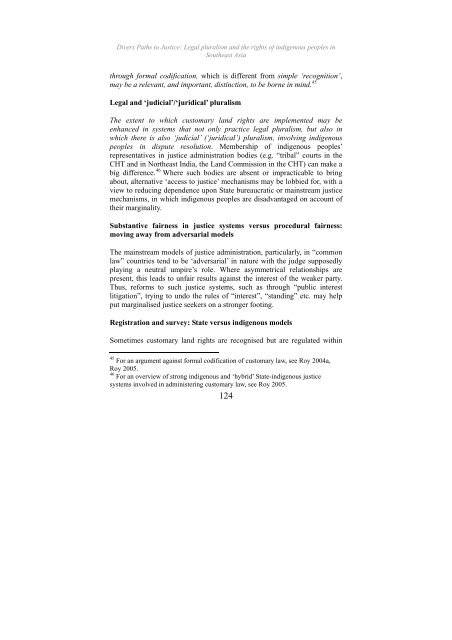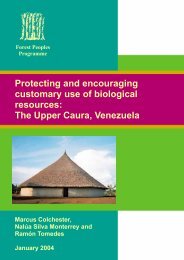Divers Paths to Justice - English - Forest Peoples Programme
Divers Paths to Justice - English - Forest Peoples Programme
Divers Paths to Justice - English - Forest Peoples Programme
You also want an ePaper? Increase the reach of your titles
YUMPU automatically turns print PDFs into web optimized ePapers that Google loves.
<strong>Divers</strong> <strong>Paths</strong> <strong>to</strong> <strong>Justice</strong>: Legal pluralism and the rights of indigenous peoples inSoutheast Asiathrough formal codification, which is different from simple ‘recognition’,may be a relevant, and important, distinction, <strong>to</strong> be borne in mind. 45Legal and ‘judicial’/‘juridical’ pluralismThe extent <strong>to</strong> which cus<strong>to</strong>mary land rights are implemented may beenhanced in systems that not only practice legal pluralism, but also inwhich there is also ‘judicial’ (‘juridical’) pluralism, involving indigenouspeoples in dispute resolution. Membership of indigenous peoples’representatives in justice administration bodies (e.g. “tribal” courts in theCHT and in Northeast India, the Land Commission in the CHT) can make abig difference. 46 Where such bodies are absent or impracticable <strong>to</strong> bringabout, alternative ‘access <strong>to</strong> justice’ mechanisms may be lobbied for, with aview <strong>to</strong> reducing dependence upon State bureaucratic or mainstream justicemechanisms, in which indigenous peoples are disadvantaged on account oftheir marginality.Substantive fairness in justice systems versus procedural fairness:moving away from adversarial modelsThe mainstream models of justice administration, particularly, in “commonlaw” countries tend <strong>to</strong> be ‘adversarial’ in nature with the judge supposedlyplaying a neutral umpire’s role. Where asymmetrical relationships arepresent, this leads <strong>to</strong> unfair results against the interest of the weaker party.Thus, reforms <strong>to</strong> such justice systems, such as through “public interestlitigation”, trying <strong>to</strong> undo the rules of “interest”, “standing” etc. may helpput marginalised justice seekers on a stronger footing.Registration and survey: State versus indigenous modelsSometimes cus<strong>to</strong>mary land rights are recognised but are regulated within45 For an argument against formal codification of cus<strong>to</strong>mary law, see Roy 2004a,Roy 2005.46 For an overview of strong indigenous and ‘hybrid’ State-indigenous justicesystems involved in administering cus<strong>to</strong>mary law, see Roy 2005.124
















